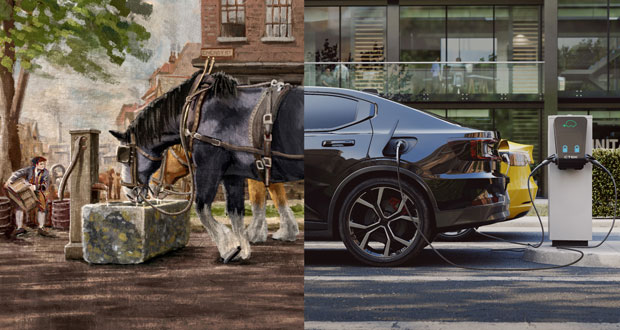Vehicle charging solutions business, CTEK, is predicting a significant growth in electric vehicle (EV) charging at destinations like offices and other workplaces, as sustainable transport goes full circle.
With more and more motorists relying on EVs for their journeys, the availability of reliable chargers at destinations is paramount. And drivers are now expecting to refuel at destinations in the same way as, in the days of horses and carriages, people would ‘refuel’ their horses while they were at work or visiting a client, before setting off again.
This trend towards destination charging is supported by a YouGov/CTEK survey that revealed that, while 68 per cent of UK EV drivers still prefer to charge at home, more than a third (37 per cent) are now using public or destination chargers, 12 per cent are charging at work and 9 per cent at petrol stations.
Cecilia Routledge, CTEK’s Global Head of E-Mobility, said: “With previous estimates of up to 90 per cent of EV charging taking place at home, this is a fairly significant shift, and we can expect destination charging to really come to the fore as business picks up and people start returning to the workplace.
“The installation of reliable EV chargers is becoming increasingly important to companies and business owners looking to meet the needs of their staff and clients, who will be reassured to know they can park up and recharge their vehicles on site before returning home, or for whatever journey they face next. The provision of EV charging facilities will also help companies meet their sustainability targets, supporting a cleaner, greener future for us all.”
CTEK recommends that, for destination chargers where drivers are parked up for several hours or overnight, expensive rapid charge DC (direct current) chargers are rarely needed, and that AC (alternating current) chargers that deliver charge at varying speeds are generally more than adequate.
For property owners looking for a cost-effective way of installing CTEK advises to install a dual socket charger, where two vehicles can plug in and charge at the same time. This can halve the number of physical units that need to be installed, and at considerably reduced cost. This is especially so as the dual socket chargers qualify for two Government Workplace Charging Scheme (WCS) grants. The £350 WCS grants are available ‘per socket’ and not ‘per charger’, so you’ll get £700 back for every dual socket charger installed, up to a maximum of £14,000 for a network of 20 dual socket chargers.
“People used to arrive at their destination on a charger, now they expect to plug into one,” said Routledge. “With the Government set to phase out petrol and diesel vehicles by 2030, the future of sustainable transport lies with rechargeable vehicles.”
“Customer engagement” has become a buzzword in the facilities management sector. Typically, it’s talked about as something radical and transformative – which can make it sound expensive, intimidating and overwhelming.
While customer engagement can be transformative for service providers, it isn’t out of reach. It’s the surprisingly simple secret ingredient in your recipe for standing out, streamlining operations and satisfying everyone involved.
Localz has produced a free eBook explaining how you can make the last mile, and the entire day of service, awesome.
To download the eBook click here.





